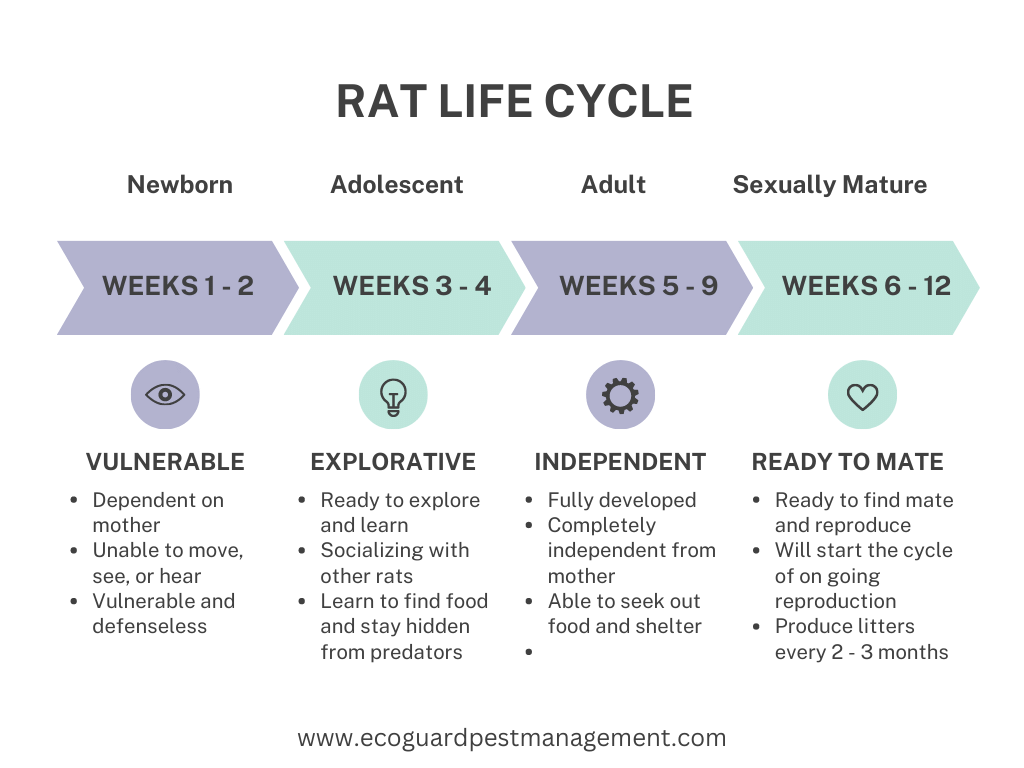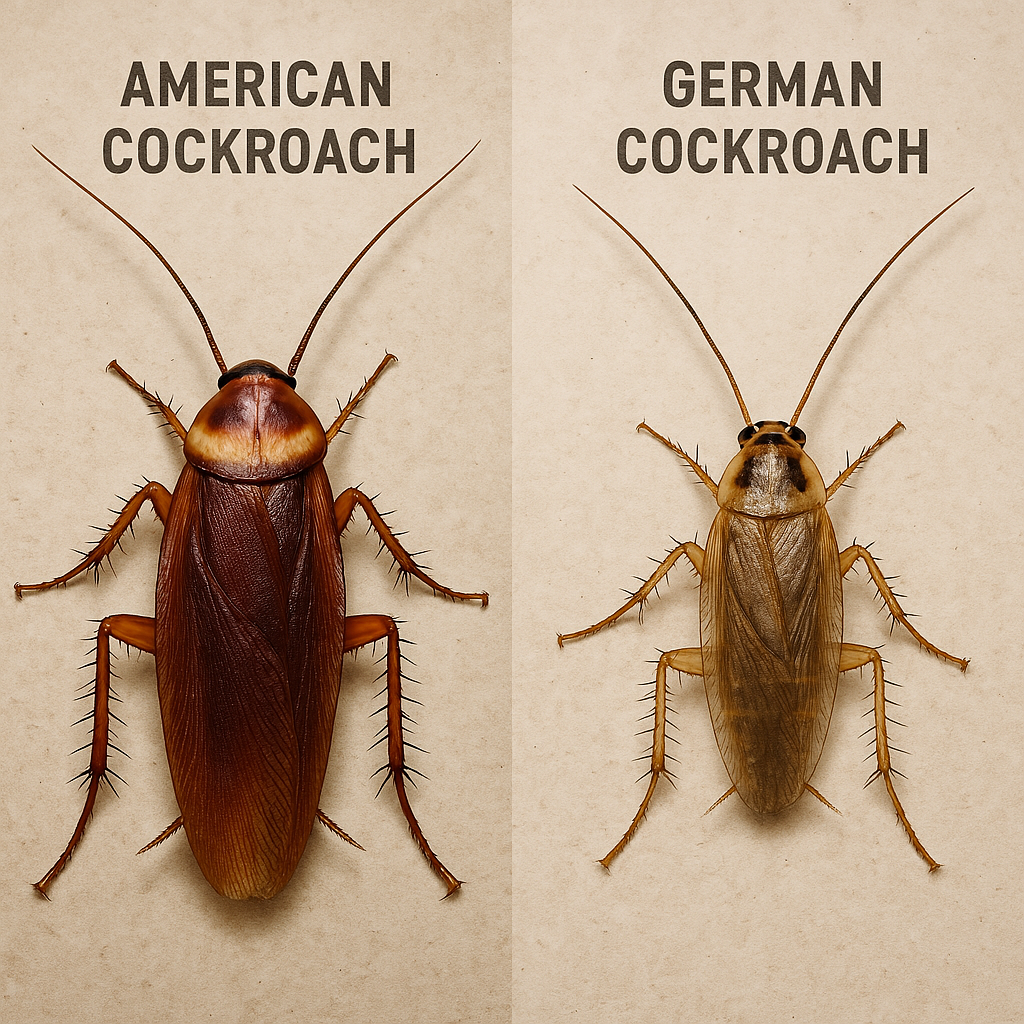How Long Do Rats Live?
Rats typically live up to a year on average, but in that time, they proliferate rapidly. Rats are notorious for breeding quickly and frequently once they reach sexual maturity. Baby rats grow up fast and are able to take care of themselves by week 3. These rats then reach sexual maturity by week 5 - 12. By that time, female rats will have started the reproduction cycle and will typically have a litter of their own on the way. The reason this is extremely concerning is because while most wild rats generally live for around 1 year, rats that live in optimal conditions can live for 2 to 3 years. Regardless of how long a rat survives, an adult rat can produce up to 6 litters a year with each litter having as many as 12 rat pups. Under normal circumstances one fertile rat can produce around 70 – 80 rats in a year. With those kind of numbers, 1 fertile rat and her subsequent offspring can compound exponentially into well over a million rats in under a year. That being said, the survival and reproduction rates typically fall under those benchmarks due to limited resources or predation.
Rat Life Cycle
Understanding a rat’s lifespan begins with understanding the rat life cycle. Each stage of a rat’s life comes with its own set of risks and threats that can cut a rat’s life short. Rats enter this world in litters with between 6-12 other baby rats. They start off blind, bald, and unable to support themselves in any way, but they quickly grow into capable rats in a short period.

Week 1 - 2: Rat babies start their lives extremely vulnerable and completely dependent on their mother. Their eyes and ears are still closed, and they are completely hairless, which is why they are also known as “pinkies. By week 2, the babies will open their eyes, their ears will unfold, and they will start to develop fur. During this period, rat babies will be exposed to the elements and predators with no way to defend themselves or change their environment. They are completely at the mercy of nature and rely 100% on their mothers to ensure their survival.
Week 3 - 4: By week 3, the rats will be adolescents known as “pups” or “kits.” They will start to move around and venture out on their own for their first time. This time of their lives is critical because they will learn valuable life skills that will help them forage for food, stay hidden from predators, and socialize amongst other rats. If critical life skills are not developed quickly enough, there is a strong chance that an adolescent rat may be picked off by a predator.
Week 5 - 9: Sometime between weeks 5 – 9, rats will reach adulthood and be completely independent. They will leave their mother and seek out their own meals. Even though they are independent, rats are pack animals that will nest together. Each pack will have at least one dominant male that is the pack leader. Staying in packs will allow rats to mate easily and rear their young safely while mothers go search for food.
Week 6 - 12: By the time rats reach adulthood, they will start to look for mates to have litters with. Males will be ready to reproduce earlier than females and will start looking for mates between weeks 6 – 10 while females will be ready to produce litters between weeks 8 – 12. Since rats are pack animals, females will strive to mate with the dominant male to ensure their young have the strongest chances for survival.
Once rats reach sexual maturity, they will start cycling through litters every 4 - 8 weeks, producing between 6-12 babies in each litter. The full-term gestation period is roughly 21 days with only 1 -2 days necessary to recover and breed before becoming pregnant with the next litter.
When Do Rats Reach Maturity?
Roof Rats
A roof rat typically becomes sexually mature between 2 - 3 months. Their litters are slightly smaller and less frequent, only producing between 4 - 8 pups 4 – 6 times a year. After the litter is born, roof rats can get pregnant again in less than 48 hours.
Norway Rats
Norway rats will generally reach sexual maturity by 3 months. The litter size is slightly larger than roof rats, with Norway rats producing between 8 – 12 pups roughly 4 – 7 times a year. Like roof rats, Norway rats can also come in heat and get pregnant all within a 2-day window after having a litter.
If resources are readily available and the environment is conducive to reproduction, rats will breed regularly and as frequently as possible. However, for wild rats that do not have access to a secure source of food and shelter, they will most likely limit reproduction to spring and fall when most rodents seasonally procreate.
What Else Determines a Rat’s Lifespan?

How long rats will live is extremely difficult to estimate but it usually dependent on factors like species, sex, health, genetics, circumstances, and access to food and shelter. Female rats typically live longer than male rats given similar circumstances. It is uncertain why, but this may be due to male rats being more exploratory and aggressive than female rats. Female rats will usually be mothers with litters they need to care for which may limit the distance from the nest they are willing to travel in search of food. Males on the other hand may stray farther in search of food which exposes them to more potential threats.
Wild rats are open to predation and also have to fight off starvation, rat diseases, and the elements. This usually limits wild rats’ lifespans to about a year on average. Domesticated rats on the other hand, have typically been known to live for 2 - 3 times that because they are given what they need to survive comfortably and don’t have to worry about predators like cats and birds.
Even the species of rat seems to have some impact on how long a rat survives. Brown rats average a little longer lifespan at 2 years while black rats typically live to 1 year. Since there are so many variables in play, it is difficult to say if the differences in lifespan are simply genetic or if they are a result of environmental impacts as brown and black rats tend to thrive in different habitats. Brown rats are commonly known as Norway or sewer rats and these rats tend to stay under cover and live-in burrows and sewers away from predators. Black rats are a little smaller but are still larger than a mouse. They are better known as tree or roof rats, and as their name implies, they live in high up places like tree branches and roofs. This exposes them to rat deterring threats like predatory birds and cats which may impact their overall longevity.
How Long Can Rats Live Without Food & Water?
The availability of resources has a big impact on the survival and procreation of rats and most rodents as well. Surviving situations where there are not enough resources can only last for so long before the rat ends up dying from hunger or dehydration. When resources are not available, rats will leave a nest in search of new places to find food. In this search, they may have to expose themselves to predatory animals, traps, or other obstacles that can cut their lives short.
How long can rats live without food?
Determining how long a rat can survive without food can be difficult but most rats can survive for roughly a week without food. Anything longer than that and the rat will most likely not be able to consume enough calories to survive. Before this time comes, rats will have become desperate and most likely will consume just about anything else available before starving.
It is also important to note that while food sources may be cut off, rats have been known to store food like squirrels and chipmunks so they may have reserves available to keep them alive through times of need.
How long can rats live without water?
Rats are small enough creatures that their need for water isn’t too difficult to maintain. They are able to get most of their water through the foods they eat so they don’t need to drink as much as they eat.
Common Health & Genetic Problems That Can Cut a Rat’s Life Short

Rats are prone to several health problems and genetic defects like respiratory problems, heart disease, and cancer that can reduce a rat’s lifespan.
- Respiratory problems can cause disease and infection in young rats with weak immune systems. This is because they are constantly exposed to filth and contaminants which can lead to an early death.
- Heart disease is an extremely common cause of death in rats. This is likely the result of a genetic defect or condition that weakens the heart. Once this condition is found in a population, it doesn’t take long for it to be prevalent within a community of rats as they interbreed amongst those within the pack.
- Cancer is another regular occurrence within rats. They have been found with multiple types of cancer that affect the different parts of their body.
- Parasites like protozoa, tapeworms, and pinworms can all infect rats. These parasites can have a significant impact on the overall health of a rat which can lead to malnourishment, bleeding, and even death.
How Long Do Rats Live After Eating Poison?
Natural threats are not the only thing that rats need to worry about. Rats are a hazardous rodent type that are usually targeted by pest control in order to keep their populations under control. This means that they can get caught in traps as well as fall for poisonous treats. Treating rats with poison can get complicated though because rats generally don’t eat rodenticide and die on the spot. The poisons used to get rid of rats typically work slow enough for the rat to wander off and die somewhere else completely. The speed at which they die is generally determined by the type of poison used.
- Anti-coagulants: Rodenticides like Warfarin and Fumarin are slow acting rat killers that work over the course of a couple days.
- Bromethalin: This rodenticide is a neurotoxin that attacks the liver and brain. It takes a couple hours after feeding on the rodenticide for the rat to die.
- Vitamin-based: This method just causes an overdose of Vitamins A, D, E, K which take about a day to kill the rat.
It is important to keep in mind that most poisons take some time to take effect which means that a poisoned rat can make it into your home and die somewhere inaccessible. It is always recommended that baits are used outside only and that proper exclusion strategies have been implemented to minimize the chance of rodents moving inside to die. It is also important to remember that poisoned rats need to be removed and properly discarded whenever possible to avoid passing that poison on to an unsuspecting predator animal or pet.
Contact EcoGuard Pest Management if You Have Seen Signs of Rats
If rats are making their way into your home, they can become a significant problem very quickly. It is best to enlist the help of qualified rodent control experts who specialize in exterminating rats. The team at EcoGuard Pest Management is qualified and experienced using integrated pest management techniques and rodent exclusion strategies that are designed to rid your home of rats and ensure that they stay away. Our services also include rodent clean up to ensure that all of your rat problems are completely resolved. Call today to schedule a rat inspection immediately.

















